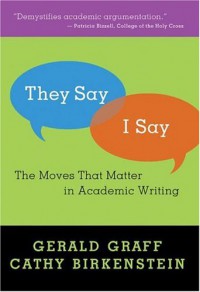209
Followers
95
Following
book reviews forevermore
Goodreads refugee and wordpress blogger
“The more I read, the more I acquire, the more certain I am that I know nothing.”
― Voltaire
 Very interesting premise, namely, looking at academic writing as participating in a dialogue. It's a fascinating idea that goes back to at least Greek roots in the Socratic dialogue. (Come to think of it, some Eastern teachers use that technique as well; I'm just not well-versed in non-Western history). I think it's a technique that helps a student place their work in a larger conversation, and elevate an academic essay above the "explanatory" work into a work that defends or promotes a viewpoint. The writers' mission can be summed up: "Yet despite this growing consensus that writing is a social, conversational act, helping student writers actually participate in these conversations remains a formidable challenge. This book aims to meet that challenge. Its goal is to demystify academic writing by isolating its basic moves, explaining them clearly and representing them in the form of templates."Broken into four parts, the first part is called, "They Say," and gives students examples of how to take a position, then summarize and quote others in their works. The second section, "I Say," leads the writer how to respond to the "they say" arguments, and how to distinguish one's own position from differing ones. (Incidentally, my professor had us read Martin Luther King's "Letters from a Birmingham Jail" which uses nearly every instance of these techniques, and is a truly impressive essay. For that alone, I'm grateful to her). The third section addresses analysis and conclusions, and shows how to connect the parts, using one's own voice and metacommentary.The last section addresses writing within specific settings, namely, writing for science, in the social sciences, entering class conversations and deciphering author viewpoints.Each chapter ends with a few exercises which lead the reader through understanding the technique and how to implement it.Contains templates to help beginning academic writers formulate ideas, and has a number of specific suggestions throughout to help writers integrate these techniques.Overall, an interesting read for an academic book. It was required reading for an English Composition class. I wouldn't have mind having run into this in high school or college when I first started academic writing. Four stars for quality of ideas, approachability and useful techniques, if not actual enjoyment.
Very interesting premise, namely, looking at academic writing as participating in a dialogue. It's a fascinating idea that goes back to at least Greek roots in the Socratic dialogue. (Come to think of it, some Eastern teachers use that technique as well; I'm just not well-versed in non-Western history). I think it's a technique that helps a student place their work in a larger conversation, and elevate an academic essay above the "explanatory" work into a work that defends or promotes a viewpoint. The writers' mission can be summed up: "Yet despite this growing consensus that writing is a social, conversational act, helping student writers actually participate in these conversations remains a formidable challenge. This book aims to meet that challenge. Its goal is to demystify academic writing by isolating its basic moves, explaining them clearly and representing them in the form of templates."Broken into four parts, the first part is called, "They Say," and gives students examples of how to take a position, then summarize and quote others in their works. The second section, "I Say," leads the writer how to respond to the "they say" arguments, and how to distinguish one's own position from differing ones. (Incidentally, my professor had us read Martin Luther King's "Letters from a Birmingham Jail" which uses nearly every instance of these techniques, and is a truly impressive essay. For that alone, I'm grateful to her). The third section addresses analysis and conclusions, and shows how to connect the parts, using one's own voice and metacommentary.The last section addresses writing within specific settings, namely, writing for science, in the social sciences, entering class conversations and deciphering author viewpoints.Each chapter ends with a few exercises which lead the reader through understanding the technique and how to implement it.Contains templates to help beginning academic writers formulate ideas, and has a number of specific suggestions throughout to help writers integrate these techniques.Overall, an interesting read for an academic book. It was required reading for an English Composition class. I wouldn't have mind having run into this in high school or college when I first started academic writing. Four stars for quality of ideas, approachability and useful techniques, if not actual enjoyment.







